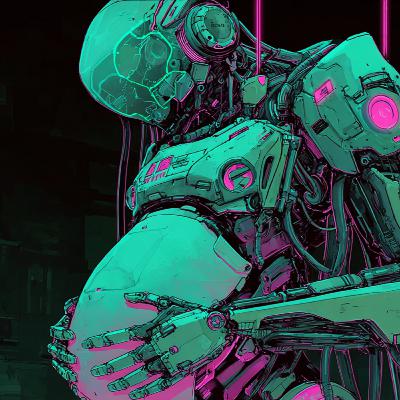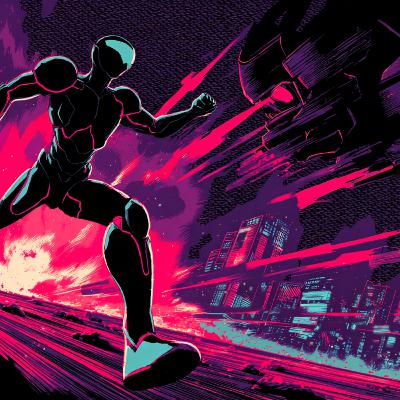Discover Kami and Canon - Anime and Manga Lore and Japanese Folklore
Kami and Canon - Anime and Manga Lore and Japanese Folklore

Kami and Canon - Anime and Manga Lore and Japanese Folklore
Author: CTDev
Subscribed: 0Played: 3Subscribe
Share
© CTDev
Description
Welcome to the definitive deep-dive into the mythological roots of Japanese pop culture. Join us on a journey from the vibrant screens of modern anime and manga to the timeless world of Japanese folklore. Together, we'll explore how the tales of mischievous yokai, powerful kami, and legendary samurai have shaped the characters and conflicts in the anime and manga you love.
99 Episodes
Reverse
Join us for a visceral deep dive into the rusty, red-light districts of terraformed Mars in the seminal 1995 OVA, Armitage III. While its famous contemporary, Ghost in the Shell, sought the soul in the digital ether, Armitage III found it in the biological "matrix" of the womb. In this podcast episode, we explore how legendary writer Chiaki J. Konaka inverted classic Lovecraftian horror tropes to tell a story where the "Other" isn't a monster to be feared, but a mother to be embraced. We analyze the "Third Type" androids, the subversion of the Pinocchio trope, and the provocative argument that in a dying world, the artificial capacity to create life is the ultimate proof of a soul.
The central "toxic romance" isn't just drama; it's a complex metaphor for the fashion industry. The "bittersweet" ending, where Yukari and George separate , is actually the ultimate feminist triumph , proving her agency by choosing a path of pragmatic commerce over following a man for pure, impractical art.In this podcast episode, we're diving into the world of Ai Yazawa's Paradise Kiss. The story is centered on the "Paradise Kiss" atelier, an independent fashion collective , that functions as a "liminal space" between the rigid, "monotone world" of Japanese academia and the chaotic passion of artistic creation. We'll discuss how the series is deeply rooted in the real-world Harajuku counter-culture , with each character embodying a specific subculture, from the Vivienne Westwood-inspired punk of Arashi to the Lolita and Dandy styles of Miwako and George.The central focus of this podcast will be the deconstruction of the series' main relationship. The "bad romance" between Yukari and George is deliberately portrayed as "toxic" and "manipulative". We explore how this relationship serves as a crucible for Yukari's "coming of agency" and functions as a complex metaphor for the fashion industry itself—alluring and "gorgeous" , but also exploitative and "abusive". Finally, our episode will analyze the "bittersweet" ending , examining why Yukari and George's separation is not a romantic tragedy, but a necessary and mature resolution that solidifies the story's core themes of art versus commerce and completes Yukari's feminist journey to true independence.
Bubblegum Crisis uniquely synthesizes the grim philosophies of Western cyberpunk (like Blade Runner and Neuromancer) with the high-energy, rebellious aesthetic of a rock-and-roll music video, creating a world where fighting corporate dystopia is a stylish, musical act of defiance.In this podcast episode, we take a deep dive into the 1987 OVA, Bubblegum Crisis, to analyze its foundational role in the cyberpunk anime genre. We'll begin by exploring the world of MegaTokyo 2032, a society teetering on the edge of collapse under the glossy, unsustainable prosperity created by the monolithic Genom Corporation. This episode examines how the series draws from the philosophical questions of Philip K. Dick and the corporate-dominated landscapes of William Gibson, but adapts these themes into something new. A key focus of our discussion is the show's unique fusion of neon-noir aesthetics, inspired by Blade Runner, with the high-octane, rebellious energy of rock and roll, heavily influenced by the film Streets of Fire. We'll break down the core technologies of the series, contrasting the oppressive Boomers with the empowering Hardsuits of the Knight Sabers. The podcast also explores the deeper themes of technocapitalism, transhumanism, and the pragmatic, often contradictory, nature of the Knight Sabers' fight for justice in a world they are still a part of. Finally, this episode discusses the lasting legacy of Bubblegum Crisis as a masterful synthesis that defined a generation of cyberpunk storytelling.
The protagonist's cybernetic abilities are not just a superpower but a direct manifestation of her psychological trauma; her power to manipulate technology is born from her need to dissociate from the physical world that abused her.In this podcast episode, we delve into the dense cyberpunk world of Mardock Scramble: The First Compression. The discussion focuses on how the film uniquely repurposes classic genre tropes to tell a deeply personal story of psychological recovery. We explore the journey of the protagonist, Rune Balot, a young girl who is violently murdered and reborn as a powerful cyborg. This podcast examines the central idea that her newfound abilities are not just technological enhancements but are intrinsically linked to the profound trauma she endured. We analyze how her power to manipulate electronics, known as "Snark," is presented as an extension of the psychological defense mechanisms she developed to survive abuse. The episode also discusses the film's take on the mind-body problem, where Balot's consciousness must learn to inhabit a new, weaponized form, and how her relationship with the sentient AI, Œufcoque, becomes the key to her healing and reclaiming her own agency.
The film inverts classic cyberpunk tropes (like those from Philip K. Dick) by arguing that the real monster isn't the un-empathetic AI, but the cruel human society that tortures a loving, empathetic android until she becomes a destructive force.In this podcast episode, we explore the 2001 anime masterpiece Metropolis, a film that uses its cyberpunk setting to deliver a powerful message about the failure of human empathy. We'll begin by discussing the film's unique creative origins, a synthesis of Fritz Lang's 1927 expressionist epic, Osamu Tezuka's 1949 manga, and the cyberpunk sensibilities of screenwriter Katsuhiro Otomo. This podcast delves into the film's world-building, analyzing the vertically stratified city that physically separates the wealthy elite from the impoverished masses and the robot underclass. The core of our discussion in this episode is the tragic journey of Tima, an advanced android who awakens without memories. We'll trace how she develops a human-like consciousness through her bond with the boy Kenichi, only to have her identity shattered by human cruelty. This podcast argues that Metropolis offers a profound inversion of typical "AI rebellion" narratives, suggesting that the final catastrophe is not a product of cold machine logic, but a direct result of unbearable emotional trauma inflicted by humans. Finally, we'll touch on the film's unique "retro-futuristic" aesthetic, which blends vintage character designs with a stunningly detailed world and an anachronistic jazz soundtrack to create a timeless and heartbreaking story.
The central "System" in Solo Leveling isn't just a magical power-up; it's a direct allegory for South Korea's hyper-competitive "hustle culture," filtered through the lens of its national pastime: MMORPGs.In this podcast episode, we conduct a deep-dive analysis of the central premise of Solo Leveling: the mysterious, game-like interface known as "The System." We begin by breaking down its in-world mechanics, from stat allocation and skill trees to the daily quests that enforce a relentless training regimen on the protagonist, Sung Jinwoo. This podcast then explores the real-world source code for this concept, tracing its origins to South Korea's unique and deeply ingrained gaming culture, the rise of "PC bangs," and the legitimization of esports as a path to social mobility. Our discussion analyzes how the series uses this MMORPG framework as an allegory for the nation's hyper-competitive "hustle culture." Finally, this episode examines the narrative consequences of the System, detailing how it drives the plot's rapid power scaling and orchestrates Jinwoo's profound transformation from the "Weakest Hunter" into an emotionally distant monarch, raising questions about the true cost of power.
The central energy source of the series, Spiral Power, is not just a generic anime power system but a direct and deliberate dramatization of Friedrich Nietzsche's philosophical concept of the "will to power."In this podcast episode, we delve into the core concept that drives Tengen Toppa Gurren Lagann: Spiral Power. Presented as the energy of "fighting spirit," this force is much more than a simple plot device. This podcast explores how Spiral Power serves as a direct allegory for Friedrich Nietzsche's philosophical idea of the "will to power"—the fundamental drive of all life to grow, expand, and overcome limitations. We will analyze the in-universe mechanics of this power, including its ultimate, paradoxical consequence known as the Spiral Nemesis. The episode also examines the central conflict between Team Dai-Gurren's philosophy of infinite evolution and the Anti-Spirals' ideology of self-imposed stagnation, which reflects Nietzsche's concepts of the Übermensch and the "Last Man." Finally, this podcast discusses how protagonist Simon's personal journey embodies existentialist themes of self-creation and how the series' unique animation and iconic soundtrack are masterfully integrated to express these profound philosophical ideas.
The dystopian system doesn't just oppress its citizens with force; its most insidious tool is the monopolization of hope. The dream of ascending to the sky-city Zalem is a carefully constructed lie that channels individual ambition into self-destruction, making the personal tragedy of its characters a microcosm of the entire oppressive structure.In this podcast episode, we explore the dense cyberpunk world of the 1993 Battle Angel OVA. This podcast will analyze how the anime uses its setting not just as a backdrop, but as a core narrative engine for its themes of class struggle and existentialism. We begin by examining the vertical dystopia of the sky-city Zalem and the Scrapyard below, discussing how this physical structure represents an inescapable social hierarchy and an ideological system that controls the populace by selling a false dream of ascent. The episode then delves into the theme of bodily commodification, where cybernetic enhancement is a grim necessity for survival, turning the human form into mere hardware to be bought, sold, and harvested. Finally, this podcast will trace the protagonist Gally's journey as an amnesiac cyborg, framing her story as an existentialist myth about creating one's own identity and meaning in a brutal, indifferent world.
The idea that the story's "miserable" ending, which leaves every character unhappy, is actually its core thematic statement, reframing a shared, permanent state of suffering as a "precious wound" that forms the basis of a true relationship.In this podcast episode, we delve into the core concept of Kizumonogatari: its unique and complex depiction of vampirism. The episode begins by analyzing how the series synthesizes the familiar Western gothic vampire with the overwhelming, calamitous power of Japanese yōkai and oni to create a truly distinct monster. We then discuss how this mythological framework serves the narrative's deeper psychological themes. This podcast explores the protagonist Koyomi Araragi's journey, not as a hero's quest, but as a deconstruction of his self-destructive altruism. The episode also examines the character of the vampire Kiss-shot, for whom immortality is not a prize but a curse of profound loneliness. Finally, this podcast analyzes the story's unconventional conclusion—a "miserable" compromise that leaves its characters permanently and unhappily bound. We discuss how this outcome, framed as a "precious wound," reflects the Japanese aesthetic of mono no aware and presents a challenging perspective on the nature of human connection.
The 2017 film adaptation of Blame! deliberately reframes the manga's esoteric, atmospheric horror into a character-driven survival story, making it a fascinating case study in how complex cyberpunk themes can be translated for a modern audience.In this podcast episode, we conduct a deep-dive analysis of the cyberpunk elements in the 2017 film adaptation of Blame!. We begin by exploring the film's core subject: how it translates the famously dense and atmospheric manga into a more accessible, character-focused narrative. The discussion in this episode covers the foundational technologies of its world, including the incomprehensibly vast Megastructure, the lost digital utopia of the Netsphere, and the tyrannical security system known as the Safeguard. This podcast also examines the philosophical underpinnings of the story, touching on themes of transhumanism, posthumanism, and the existential dread of a world where humanity has lost control of its own creations. A significant portion of the episode is dedicated to analyzing the adaptation itself, focusing on the narrative shift from the manga's stoic protagonist, Killy, to the relatable human struggles of Zuru and the Electro-Fishers, and how this choice reframes the story's central themes for a contemporary audience.
The idea that Kaiba's whimsical, childlike art style isn't just a stylistic choice, but a deliberate meta-critique of the cyberpunk genre's tendency to aestheticize dystopia, forcing a more direct and horrifying confrontation with its themes.In this podcast, we explore Masaaki Yuasa's 2008 anime, Kaiba, a series that deconstructs the cyberpunk genre. The episode begins by examining the core technology of the series: the ability to digitize memory and transfer consciousness between bodies. We discuss how this creates a brutal "memory market" where the self becomes the ultimate commodity, leading to extreme social stratification. This podcast will also delve into the philosophical consequences, such as the dissolution of personal identity and the instability of human connection in a world where memories can be altered and bodies are interchangeable. A key focus of our discussion is the show's unique "art style dissonance"—its use of a simple, childlike aesthetic to portray a dark, violent, and exploitative world. We analyze how this visual choice functions as a powerful critique of the cyberpunk genre itself, stripping away the "cool" aesthetic of dystopia to present its human cost in a raw, unfiltered way.
The series isn't just a rom-com; it's a psychological drama where each character's public persona (the "Tiger," the "Delinquent," the "Genki Girl") is a trauma response or defense mechanism, and their initial romantic pact is a necessary psychological tool to allow for genuine intimacy they couldn't otherwise handle.In this podcast episode, we explore the central theme of Toradora!: the profound gap between a person's outward appearance and their inner reality. The story begins with a simple pact between Ryuji Takasu and Taiga Aisaka to help each other with their high school crushes, but this podcast argues that this setup is merely a narrative device. The episode delves into the deeper psychological drivers of the characters, analyzing how their public personas—Ryuji's "delinquent" eyes and Taiga's "Palmtop Tiger" ferocity—are actually facades built to cope with family trauma and deep-seated insecurities. This podcast will also examine the supporting cast, including the perpetually cheerful Minori and the two-faced model Ami, to show how they too perform carefully constructed roles. We will discuss how the series uses the classic high school setting to systematically break down these masks, forcing the characters to confront their true selves as a necessary step before they can find genuine love and happiness.
In this episode of our podcast, we explore the chilling Japanese tale of the Hanged Woman of the Pass. We'll discuss how this story is not a single legend, but a fascinating combination of two distinct traditions: a specific performance piece from the oral art of Rakugo storytelling called Yūrei no Tsuji (The Ghost's Crossroads), and the broader folkloric belief in the Itsuki, or "strangling ghost." This podcast will delve into the narrative of a traveler who encounters the spirit of a wronged woman at a lonely mountain pass. We'll also examine the supernatural motivation behind her haunting, which is rooted in a folk-Buddhist concept of the underworld where a soul who died by hanging must find a replacement to be freed. The episode further analyzes the story's historical context in Edo-period Japan, its powerful themes of social injustice and karmic consequences, and the enduring legacy of its central figure—the vengeful female ghost, or onryō—in modern horror.
In this episode of our podcast, we explore "The Tale of the Bamboo Cutter," Japan's oldest surviving work of prose fiction. The podcast will begin by retelling the core narrative of Kaguya-hime, a mysterious princess discovered inside a glowing bamboo stalk who is revealed to be from the Moon. We will follow her story as she rejects five noble suitors with a series of impossible tasks and forms a unique, respectful bond with the Emperor of Japan. This episode will also delve into the rich historical context of the Heian period, a golden age of Japanese aristocratic culture, to understand the world in which the tale was created. We will analyze the story's deep thematic layers, such as the Buddhist concept of impermanence (mono no aware) and its sharp critique of materialism. The discussion will also cover the symbolism of key elements like the Moon, bamboo, and the feather robe that erases Kaguya's earthly memories. Finally, the podcast will trace the tale's enduring legacy, from its place in modern education to its many adaptations in pop culture, including the celebrated Studio Ghibli film. A central focus of our analysis will be the story's powerful conclusion, where the heartbroken Emperor chooses to burn an elixir of immortality on Mount Fuji, providing a mythical origin for Japan's most sacred landmark.
In this podcast episode, we take a deep dive into Operation Strix, the core mission that drives the narrative of Spy x Family. We'll explore how the series meticulously builds its world on the historical foundations of Cold War-era Berlin, creating the tense, paranoid state of Ostania. This podcast will analyze how this high-stakes espionage setting forces a master spy, a deadly assassin, and a telepathic child into a "fake family." Our discussion will focus on how this arrangement, born from lies and deception, paradoxically becomes a powerful therapeutic process for its three main characters, each a casualty of past conflicts. This episode examines the juxtaposition of geopolitical peace—the mission's goal—with the personal, domestic peace the Forgers find with each other, ultimately exploring the series' powerful message about the true meaning of a "found family."
In this episode, we explore the surprisingly complex world of Tottoko Hamutaro. The core of our discussion is the series' central concept: a fully realized, parallel society of hamsters known as the "Ham-Hams," who operate just beyond human sight. This podcast delves into how their community, centered around the Ham-Ham Clubhouse, functions with its own social structure and roles. A key focus of the episode will be "Ham-Chat," the unique constructed language that defines their culture and serves as a primary tool for social cohesion, a concept so vital it became a core mechanic in the video games. We will also examine the real-world foundations of the series, tracing its origins to the Japanese pet hamster boom of the late 1990s and the long-standing cultural tradition of anthropomorphism (gijinka). This podcast will discuss the profound, and sometimes tragic, real-world impact of the anime, which ignited a multi-billion dollar merchandise craze that led to a nationwide animal welfare crisis. Finally, the episode analyzes the fascinating aesthetic split between the TV show's gentle kawaii style and the theatrical films, which were directed by legendary auteur Osamu Dezaki, who brought his signature dramatic and sophisticated visual language to the world of these small hamsters.
In this episode, we investigate the story known as "The Curse of the Mibu Temple Bell." Through our research, we discovered that this specific tale does not exist as a single, traditional Japanese legend. Instead, this podcast explores how a modern myth was born from a fascinating mix of separate elements. We'll look at the real history of Mibu-dera temple in Kyoto and its connection to the Shinsengumi warriors. Then, the episode delves into the actual source of famous bell legends, the nearby Mii-dera temple, and unpacks the classic tales of the loyal bell of Benkei and the Bell of Mugen. We will also analyze the dramatic Dōjōji legend, a story of obsessive love and monstrous transformation that has a direct link to Mibu-dera through its silent theatre. Finally, the podcast examines how the video game Sekiro: Shadows Die Twice masterfully combined these threads, creating a powerful new "phantom legend" for a global audience.
In this episode of our podcast, we explore the famous Japanese folktale of Issun-bōshi, the One-Inch Boy. Many know this story as an inspiring tale of a tiny hero who bravely rescues a princess and becomes a full-sized samurai. However, this podcast delves into the story's much darker origins. We will compare the modern, sanitized version with the original tale from the medieval Otogi-zōshi collection, which presents Issun-bōshi not as a hero, but as a cunning and ambitious trickster. This episode discusses how the original character manipulates his way into a noble household and frames the lord's daughter for a crime to force her into his possession. We examine the historical context of the Muromachi period, an era of social upheaval known as gekokujō ("the low overthrowing the high"), which helps explain the original story's cynical themes. The podcast also analyzes key symbols like the wish-granting Magic Mallet and the scholarly interpretations of folklorist Kunio Yanagita, who saw Issun-bōshi's smallness as a sign of divinity.
In this podcast episode, we delve into the uncompromising and philosophically dense world of Texhnolyze. Often cited as one of the bleakest works in anime, this series functions as a powerful deconstruction of the cyberpunk genre itself. Our discussion will explore how Texhnolyze weaponizes familiar tropes to ask profound questions about human existence. We'll begin by examining the core technology of "Texhnolyzation," framing it not as an upgrade but as a source of physical pain and psychological alienation. This podcast will also analyze the morbid economy of the city of Lux, which is sustained by Raffia, a resource derived from the dead. We will then break down the city's warring factions, viewing them as different, and ultimately failed, philosophical responses to a transhumanist crisis. Furthermore, this episode will trace the show's literary roots to William Gibson and Philip K. Dick, discussing how it subverts their foundational themes. Finally, we will tackle the series' core philosophical debate between nihilism and existentialism, culminating in an analysis of the famously desolate ending and what that final, holographic flower truly represents in a world devoid of hope.
In this podcast episode, we explore the central premise of Sailor Moon: cyclical reincarnation. We begin by examining how this concept is not presented as a simple fantasy, but as a profound psychological burden and an inherited trauma from the tragic fall of the ancient Moon Kingdom. This podcast discusses how this inescapable destiny shapes the characters, particularly the reluctant heroine Usagi Tsukino, forcing them to reconcile their past lives with their present identities. The episode also analyzes the series' foundational influences, from the Greco-Roman myth of Selene and Endymion to Japanese folklore. Finally, this podcast delves into how Sailor Moon revolutionized the magical girl genre by fusing it with the team-based action of Super Sentai, using this new formula to explore themes of female friendship, love, and what it truly means to be a hero.
























